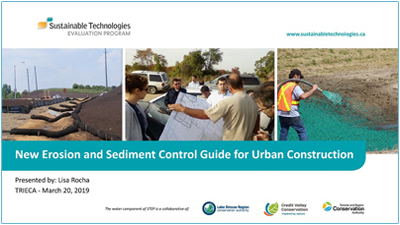TRACK 2
New Directions in Erosion and Sediment Control Guidance for Ontario: The Latest on Best Management Practices, Turbidity Targets and Performance Monitoring
ABSTRACT
In the decade since the release of the Greater Golden Horseshoe Areas Conservation Authorities Erosion and Sediment Control Guideline for Urban Construction, the practice of erosion and sediment control (ESC) has evolved in many ways — from legislative changes to the expansion of training programs and the emergence of new products and best practices.
As new products and techniques have emerged, knowledge of how to apply, design and maintain current best management practices has expanded and the limitations of some older/conventional products and techniques have been revealed.
The new ESC Guide for the Greater Golden Horseshoe Area addresses these key changes and provides practitioners with current, concise, relevant and solutions-oriented guidance on protecting the natural environment from sediment impacts during construction activities.
This presentation will provide information on the new ESC Guide, with particular emphasis on:
- New turbidity targets for receiving systems downstream of construction projects, which are based on the Canadian Standards Association Erosion and Sediment Control Inspection and Monitoring Standard released in November 2018
- Recommended methods for construction site turbidity monitoring, including the determination of background levels, strategies for troubleshooting turbidity exceedances, and implementation of appropriate reporting protocols
- The evolution of best practices guidance for erosion prevention, sediment control and isolation in and near water works.
Learning Objectives
- Gain knowledge of the key updates to the way ESC is practiced, as reflected in the new ESC Guide
- Gain an understanding of new requirements for turbidity monitoring on construction sites and the thresholds that apply, which sites they apply to, how to carry out monitoring, and what expectations apply with respect to turbidity exceedance response and reporting
- Gain an understanding of how guidance on ESC best management practices has changed and expanded to include new technologies and strategies
ABOUT THE PRESENTER

Lisa Rocha
Lisa Rocha received her undergraduate degree in environmental analysis and monitoring from University of Toronto. She has been a part of the Toronto and Region Conservation Authority‘s (TRCA) Sustainable Technologies Evaluation Program since 2005.
In her current role as project manager, she has been involved in various projects related to sustainable water management, including low impact development technologies and erosion and sediment control studies.
In addition to monitoring and research studies, Lisa has been involved in the development of guidance documents, including an application guide for the use of polyacrylamide on construction sites and the 2016 Inspection and Maintenance Guide for Stormwater Management Ponds and Constructed Wetlands.
Most recently Lisa has worked on developing an updated erosion and sediment control guide for the Greater Golden Horseshoe Area Conservation Authorities.

